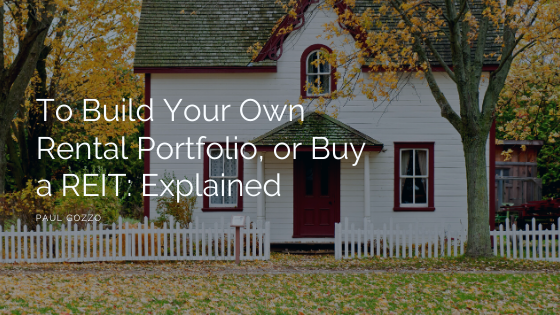A popular question amongst real estate investors that are either experienced or first starting out is, “do I build my own rental portfolio by buying the hard assets or should I just buy real estate through investment vehicles like trusts or a REIT”? If you don’t know what REITs are, in a nutshell, they allow you to buy shares in companies that currently own cash flowing real estate properties. These companies can either be publicly traded or privately held, but to make it simpler we’ll be focusing on publicly-traded REITs. Yes, it’s true that both options will increase your return on investment but the two options are very much different.
Investing Goal: Stock market safety or liquidity
Think of the real estate investing market like the stock market especially with regard to the old adage; holding onto investments as long as possible is the best approach for building wealth through either method. However, the situation with REITs is a bit different when it comes to liquidity as in when you want to sell your assets quickly to create cash, you can, unlike a “hard asset” which requires a bit more time and effort to liquidate. When you buy a property and are looking to sell it later on, it will take more time than your disposition of shares in a public REIT where you can simply call your broker or make a few clicks online. However, buying physical properties offers other upside including some tax advantages and while both investment strategies are designed to protect the investment while throwing off cash through a dividend, owning physical property can provide more upside than REITS could ever potentially in that the raw value of that asset or land can increase dramatically while with a REIT, the upside beyond the dividend is generally more predictable and stable overall. For any investor, it is important to learn their options first and then determine what their goal is second before choosing a strategy.
Investing Goal: Higher yield potential or low amount of required investment
Almost all REITS have low dividends that fall between 2-3% and sometimes even less. On the flip side, owning sole properties can result in a distribution yield of 5-8% and sometimes even higher. REITs have a lower yield than properties for three main reasons: you are buying into many properties instead of one, more costs to cover than with a single property, and REITs want to avoid dropping their dividends in the near future. While REITs may not seem attractive after mentioning some of the cons, there is one major upside: a low investment cost. Often times, a property can be out of the price range for new investors. REITs were created to resolve this issue, as some shares sell as low as $10. That certainly doesn’t mean you own a large part of a property, but you at least have your foot in the real estate investing world.
Investing Goal: Leverage vs options
With single-family real estate investing, you have the option of using a higher level of debt by leveraging a loan to finance a property up to 80% of its value, whereas with REIT investing you are limited to the maximum leverage available for all stock investors which is 50% or 2:1 leverage. For example, if you have $20,000 to invest you can purchase $40,000 worth of REIT shares with a 50% margin. However, with the same amount of money you can purchase a $100,000 unit by placing $20,000 down and financing the remaining $80,000 with a loan.
While the yields may be higher, single-family real estate investments don’t offer the various options a REIT does. When you invest in a REIT, you often invest in different assets from everything including office spaces to single-family homes. For some investors to lower their risk, they want to spread their investment across multiple properties. Even if this means they don’t own large portions of a single property, they won’t lose much of their investment in one property as where a single-family real estate investor would carry that risk greater. With all things being the same, the more leverage you have, the higher your returns will be.
Investing Goal: High ownership or low ownership
As discussed above, the more you invest in a property, the more ownership you have over that property. This is usually the case when building your single-family real estate portfolio, as with REITs you own less of a percentage in the properties you invest but the number of properties you have a stake in is much higher. The more ownership you have over a property, the higher the return on equity and return on investment you will have. The higher equity will also allow you to refinance the property in the future and build your portfolio even more. However, this option does not suit everyone. There are some people who do not want their hands completely tied and invested in real estate, so REITs are better for individuals who want to seek a return on their investment without much effort on their part. Plus, the lower the percentage of ownership they have in a property, the investors see it as less potential losses in the long run.
In conclusion, there is not a single method that will work for every prospective or existing real estate investor. There are benefits to both buildings your own rental portfolio or buying multiple REITs. The factor that will influence your decision more than anything is a risk. How much risk are you willing to take? Do you want to see potential high returns with higher risks than REIT when building your rental portfolio, or do you want to spread your investment across different properties with little to no risk with the potential for low or high returns?

